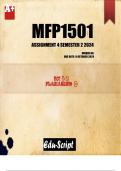MFP1501
ASSIGNMENT 4 SEMESTER 2 2024
UNIQUE NO.
DUE DATE: 8 OCTOBER 2024
, Question 1: Teaching Algebra Concepts with Patterns
1.1 Four ways to teach algebra using patterns for Grade 3 learners:
1. Using Physical Objects: To introduce algebra concepts, I can use objects like
blocks, buttons, or beads to show patterns. For example, alternating red and blue
blocks can demonstrate simple patterns, helping learners recognize sequences.
2. Visual Patterns: I can create visual patterns using shapes or colors. For
example, a sequence of triangles, squares, and circles in a repeated order helps
children spot the underlying pattern and predict the next shape.
3. Number Patterns: I will introduce numerical patterns like skip counting (e.g.,
counting by 2s, 5s, or 10s). This approach shows how numbers follow a
predictable rule, which is a fundamental idea in algebra.
4. Story-Based Patterns: I can incorporate stories or real-life scenarios to teach
patterns. For example, using a story where a character adds 3 apples to their
basket each day will help learners grasp how patterns grow consistently.
1.2 Study the pattern below:
Let’s imagine a simple repeating pattern: ★, ▲, ●, ★, ▲, ●.
1.2.1 Identify the repeating pattern:
The repeating unit here is: ★, ▲, ●.
1.2.2 How many elements does the repeating unit contain?
The repeating unit consists of 3 elements: ★, ▲, and ●.




